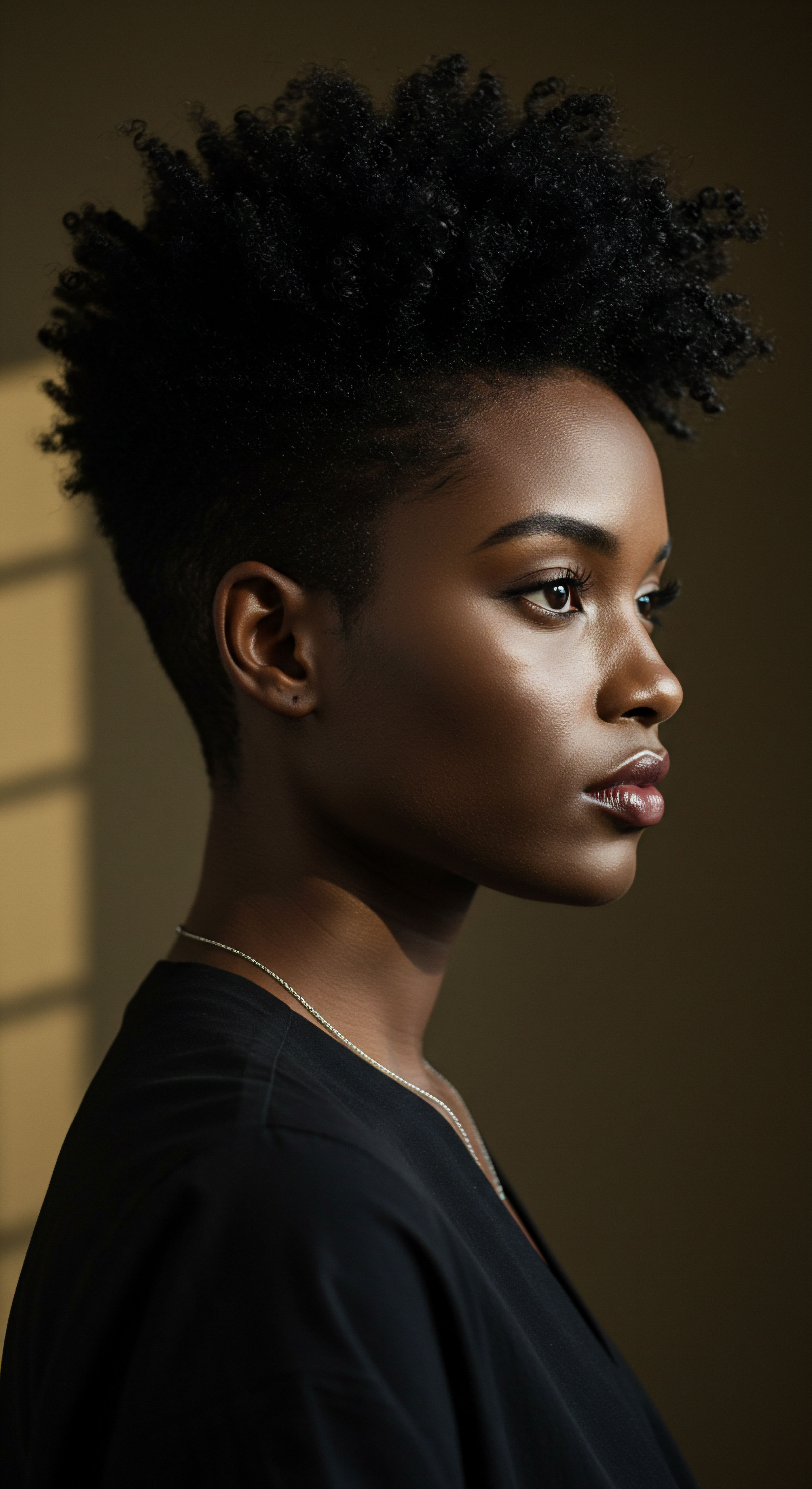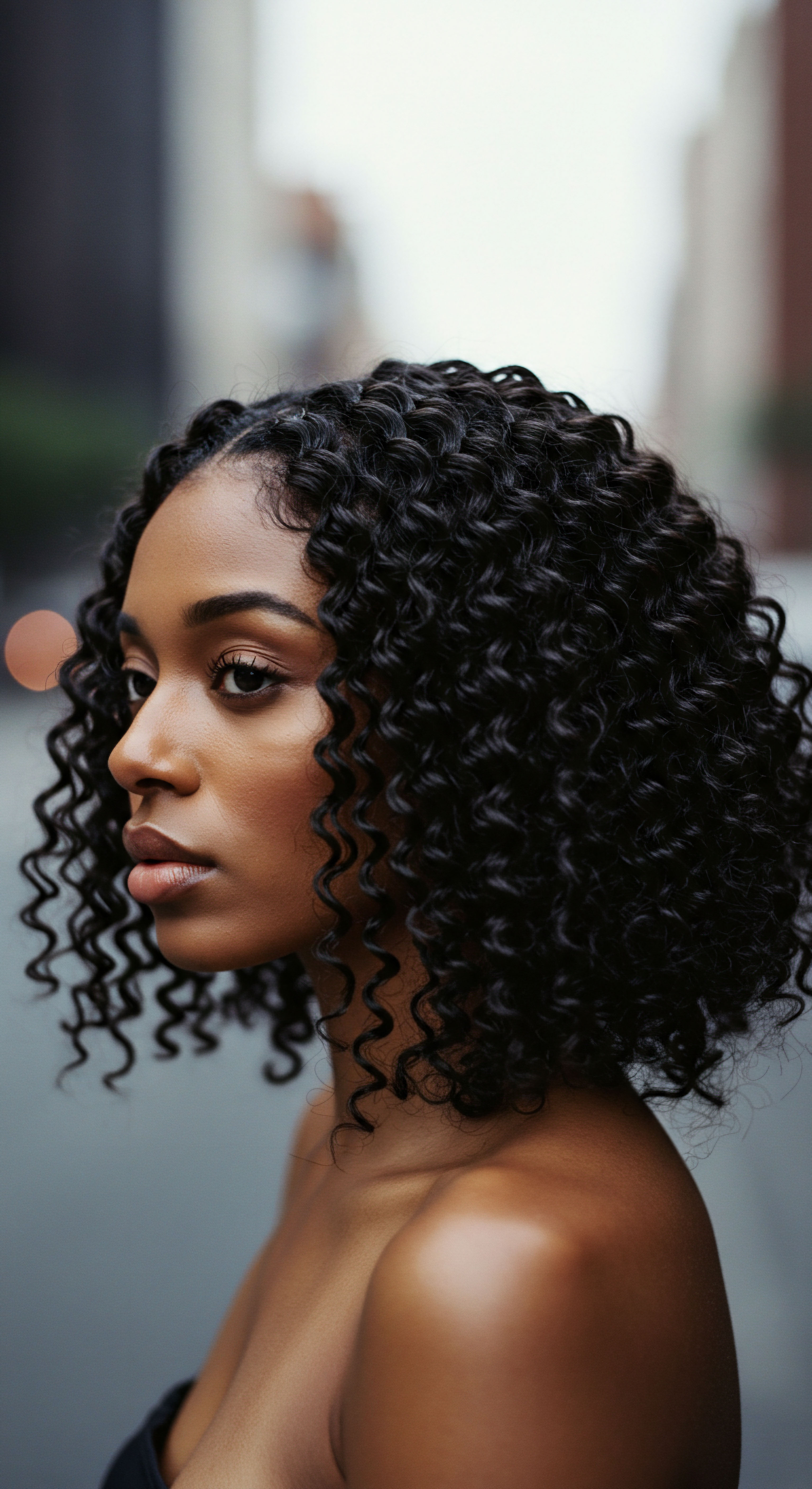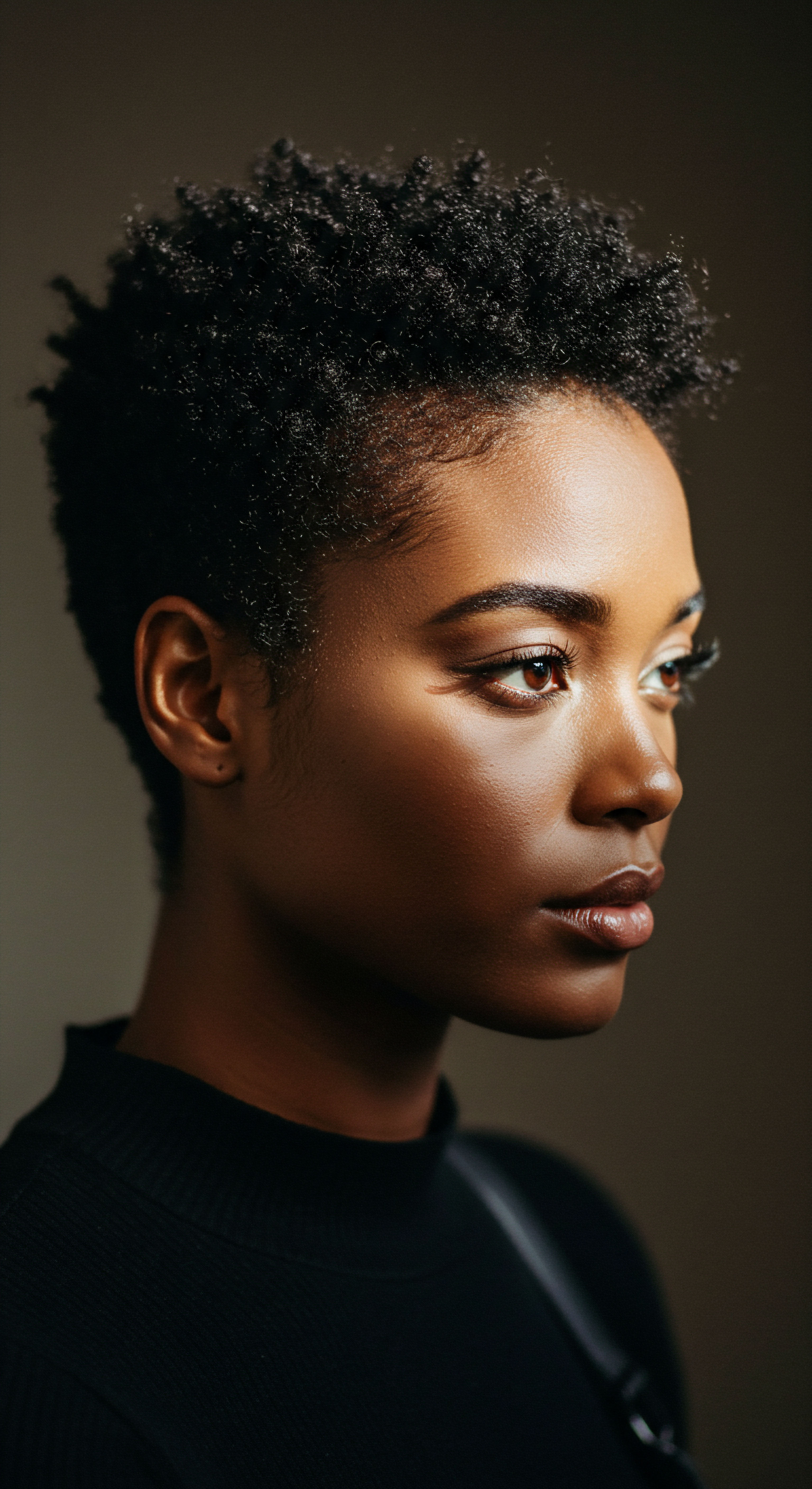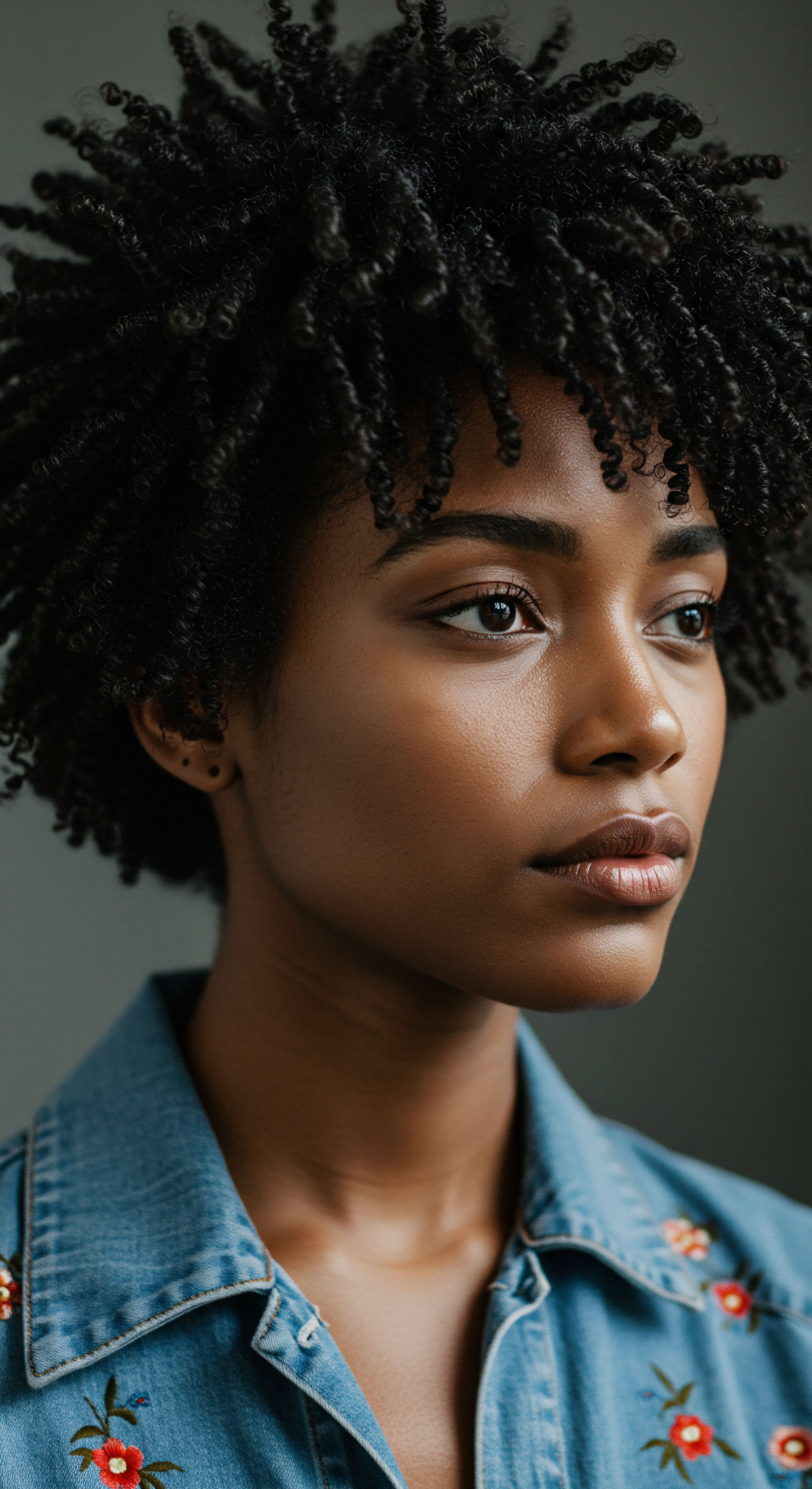
Roots
As dusk descends and the world quiets, a subtle dialogue begins between our coiled strands and the surfaces upon which we rest. This nightly interaction, often overlooked, holds a profound sway over the vitality and enduring well-being of textured hair. Consider for a moment the inherent characteristics of coiled hair, a marvel of natural engineering. Each strand, with its distinctive helical contour, possesses a cuticle layer composed of overlapping scales, much like shingles on a roof.
These scales, while protective, are also points of potential vulnerability. The very curvature of the hair fiber means that these cuticle scales are not always laid flat against the cortex, making them more prone to lifting and catching on abrasive materials. This structural reality renders coiled hair inherently more susceptible to mechanical stressors than its straighter counterparts.
The integrity of this outermost cuticle layer is paramount. It serves as the hair’s initial line of defense, a shield against environmental aggressors and daily wear. When this layer is compromised, the inner cortex, which provides much of the hair’s strength and elasticity, becomes exposed. A critical component of the cuticle surface is a lipid layer, specifically 18-methyleicosanoic acid, often abbreviated as 18-MEA.
This natural fatty acid provides a hydrophobic character, helping to repel water and, crucially, reducing friction between individual hair fibers. Its presence contributes significantly to the hair’s natural slip and luster.

What Makes Coiled Hair Uniquely Vulnerable at Night?
The geometry of coiled hair, characterized by its numerous twists and turns, naturally creates more points of contact and therefore increased potential for friction. When hair moves against a surface, especially during sleep, these contact points can snag, pull, and abrade the cuticle. This mechanical action can lift, chip, or even remove the delicate cuticle scales, leading to a roughened surface.
A damaged cuticle surface increases the coefficient of friction, meaning more force is needed for strands to slide past each other, which in turn escalates tangling and further damage. This self-perpetuating cycle can gradually diminish the hair’s natural protective qualities and overall strength.
Moreover, coiled hair textures are often predisposed to dryness due to their structure, which makes it more challenging for natural scalp oils to travel down the length of the strand. This natural dryness is then compounded by sleep surfaces that draw moisture away. A dry strand is a brittle strand, far more prone to breakage under even minimal stress. The combination of structural predispositions and nightly mechanical stress lays the groundwork for long-term hair health outcomes, emphasizing the profound significance of our sleep environment.
The intrinsic architecture of coiled hair, with its raised cuticle scales and propensity for dryness, renders it particularly sensitive to nightly surface interactions.

Ritual
The transition from the day’s activity to the quiet repose of night presents a vital opportunity for hair care, a practice deeply rooted in historical wisdom and personal devotion. For many, particularly those with coiled hair, the nighttime ritual extends beyond mere cleansing; it becomes a protective act, a silent guardian for strands that endure the day’s elements. This understanding has guided choices in sleep surfaces for generations, moving from traditional coverings to modern textiles, each with its own promise of care.

How do Various Sleep Surfaces Compare for Coiled Hair?
The choice of sleep surface plays a direct role in mitigating or exacerbating hair damage. Common pillowcase materials exhibit distinct properties that directly influence hair’s condition by morning. Understanding these differences is central to selecting a surface that truly serves the hair’s long-term well-being.
- Cotton ❉ This ubiquitous material, while soft to the touch for many, possesses a fibrous, absorbent nature. Its rougher texture creates considerable friction as hair moves against it during sleep. This friction can lead to mechanical abrasion, ruffling the cuticle layer and causing frizz, tangles, and ultimately, breakage. Furthermore, cotton is highly absorbent, drawing moisture away from hair strands and the scalp, leaving coiled hair, already prone to dryness, feeling parched and brittle.
- Satin ❉ Often presented as an alternative to silk, satin refers to a weave, not a fiber. It can be made from various materials, including synthetic ones like polyester. While smoother than cotton, offering a reduction in friction, its synthetic composition often means it lacks the breathability of natural fibers. It still offers benefits over cotton by minimizing tugging and pulling, which can reduce breakage and preserve styles.
- Silk ❉ A natural protein fiber, silk stands out for its exceptional smoothness and minimal friction coefficient. Its surface allows hair to glide freely, significantly reducing mechanical stress, tangling, and breakage. Beyond its gentle touch, silk is also less absorbent than cotton, helping hair retain its natural moisture and applied products. Its breathable and temperature-regulating properties contribute to a balanced scalp environment.
The practice of covering hair at night, often with bonnets or scarves crafted from silk or satin, is a cherished tradition, especially within Black communities. This custom, passed down through generations, serves as a physical barrier, shielding hair from the abrasive qualities of bedding and preserving moisture and style. It is an act of intentional self-care, a moment of peace and protection before rest. Historically, women also used hair wraps or braided their hair at night to maintain styles and protect length, demonstrating a long-standing understanding of hair’s vulnerability during sleep.
Consider the daily transformation many undergo, from carefully styled coils to a protected nighttime arrangement. This mindful shift acknowledges that the hours of sleep are not merely a pause but an active period for hair restoration and preservation. Choosing the right surface, whether a pillowcase or a head covering, is a tangible expression of this care, a gentle yet firm boundary against potential harm.
| Material Cotton |
| Surface Texture Rough, Fibrous |
| Moisture Interaction Absorbs moisture, leads to dryness |
| Friction Level High |
| Breathability High |
| Material Satin (synthetic) |
| Surface Texture Smooth, Mimics silk |
| Moisture Interaction Minimizes moisture loss (less than silk) |
| Friction Level Medium-Low |
| Breathability Medium-Low (can trap heat) |
| Material Silk (natural) |
| Surface Texture Very Smooth, Slippery |
| Moisture Interaction Retains moisture, less absorbent |
| Friction Level Very Low |
| Breathability High |
| Material The selection of a sleep surface significantly influences the health and hydration of coiled hair. |

Relay
To truly appreciate the deep impact of sleep surfaces on coiled hair, one must consider the intricate biophysics at play. The interaction between hair and fabric at a microscopic level is a dynamic exchange of forces, moisture, and chemical integrity. It is here, in the subtle dance of friction and hydration, that long-term hair health is either sustained or compromised.

How does the Coefficient of Friction Influence Hair Integrity?
The scientific concept of the coefficient of friction, a measure of the resistance to motion of one surface sliding over another, holds immense significance for hair. For coiled hair, which possesses a naturally higher degree of inter-fiber contact due to its shape, a high coefficient of friction translates directly into increased mechanical stress. Studies using advanced microscopy, such as Atomic Force Microscopy (AFM), have quantified these interactions, showing that silk exhibits a remarkably low coefficient of friction compared to cotton.
When hair slides across a high-friction surface like cotton, the cuticle scales are forcibly lifted, abraded, and potentially chipped away. This physical degradation weakens the hair shaft, making it more susceptible to splitting and breakage.
Beyond the direct physical damage, the loss of the 18-MEA layer on the hair’s surface, often a consequence of friction and environmental exposure, renders the hair more hydrophilic. This means it more readily absorbs and loses water, disrupting its natural moisture balance. When hair swells and contracts repeatedly due to moisture fluctuations, its internal structure experiences stress, contributing to brittleness and further vulnerability.
Microscopic analysis reveals that surfaces with lower friction coefficients significantly reduce cuticle damage and preserve hair’s delicate outer layer.
A study published in the Journal of Textile Science and Technology highlighted the stark difference in moisture retention, reporting that a silk pillowcase retained 97% of moisture, in contrast to 75% for cotton and 60% for satin. This data point is particularly poignant for coiled hair, which thrives on moisture. The nightly absorption of vital hydration by an inappropriate sleep surface can undo the benefits of even the most diligent conditioning regimens, leading to chronic dryness and an increased propensity for breakage over time.
Furthermore, research from Milbon, involving microscopic observation of hair structures across various curl shapes, found that Curly Hair Exhibits Weaker Cuticle Adhesion and Lower Hair Strength Than Straight Hair. They also confirmed a lower amount of glycoprotein, believed to contribute to cuticle adhesion, in curly hair. This finding provides a compelling biological underpinning for why coiled hair is empirically known to be more prone to damage from physical stresses like tangling and pulling.
The inherent fragility, combined with external friction from sleep surfaces, creates a cumulative burden on the hair’s structural integrity. This reinforces the need for protective measures, as coiled hair is already at a disadvantage in resisting mechanical forces.
The long-term impact extends beyond individual strands. A healthy scalp, free from irritation and excessive dryness, forms the foundation for healthy hair growth. Cotton pillowcases, by absorbing scalp oils and potentially harboring bacteria, can contribute to an unbalanced scalp environment. In contrast, smoother, less absorbent surfaces like silk support a cleaner, more stable environment, reducing potential irritation and promoting a more conducive setting for hair follicle health.
The cultural aspect of hair protection at night, often seen in practices within African and Afro-Caribbean communities, is not merely aesthetic or traditional; it is a testament to an intuitive understanding of hair science long before formal research. The widespread use of bonnets and wraps, often crafted from silk or satin, reflects a deep, lived knowledge of how to shield vulnerable hair from environmental and mechanical stressors during periods of rest. This intergenerational wisdom, now increasingly affirmed by scientific investigation, underscores the profound connection between self-care, cultural heritage, and the enduring vitality of coiled hair.
The cumulative effect of nightly surface interactions is not always immediately apparent. Hair damage is often a gradual process, a slow erosion of integrity that manifests as increased frizz, dullness, reduced length retention, and persistent dryness. Over months and years, these subtle nightly aggressions can significantly alter the hair’s overall appearance and resilience. Therefore, selecting a sleep surface is not a minor detail; it is a fundamental choice that resonates through the entire lifespan of coiled hair, shaping its health, strength, and vibrancy.

Reflection
As we conclude our exploration into the quiet hours of night and their profound influence on coiled hair, we arrive at a deeper appreciation for the interplay of science, tradition, and self-attunement. The choice of sleep surface, whether a smooth pillowcase or a comforting wrap, transcends mere preference; it embodies a gentle, yet powerful, act of care. It speaks to a recognition of hair not simply as an adornment, but as a living extension of our being, deserving of protection and respect. In this understanding, the whispers of ancestral wisdom meet the clarity of scientific insight, guiding us toward choices that honor the unique beauty and resilience of coiled hair, allowing it to flourish, even in slumber.

References
- Bhushan, B. (2013). Biophysics of Human Hair ❉ Structural, Nanomechanical, and Nanotribological Studies. Springer.
- Dhavalikar, N. & Bhushan, B. (2010). Nanomechanical characterization of human hair using nanoindentation, nanoscratch, and AFM. In Biophysics of Human Hair (pp. 95-128). Springer.
- Gamez-Garcia, M. (2005). Properties of the hair cuticle via damage analysis. Cosmetics & Toiletries, 120(10), 55-60.
- Khumalo, N. P. et al. (2200). Hair breakage in normal and weathered hair ❉ focus on the Black patient. Journal of Investigative Dermatology Symposium Proceedings, 12(1), 6-9.
- LaTorre, C. & Bhushan, B. (2005). Nanotribological characterization of human hair and skin using atomic force microscopy. Ultramicroscopy, 105(1-4), 155-175.
- Milbon Co. Ltd. (2024, June 27). Milbon Finds Curly Hair Has Weak Cuticle Adhesion and Low Hair Strength. Presented at the 21st IUPAB Congress.
- Nonomura, Y. Konno, S. & Asanuma, K. (2024). Friction Dynamics of Straight, Curly, and Wavy Hair. Journal of Textile Science and Technology, 26, 185-193.
- Robbins, C. R. (2012). Chemical and Physical Behavior of Human Hair (5th ed.). Springer.
- Swift, J. A. (1999). The examination of hair by electron microscopy. Microscopy and Analysis, 13(4), 21-23.
- Wortmann, F. J. & Schwan-Jonczyk, A. (2006). The Differential Friction Effect of Human Hair. Journal of Cosmetic Science, 57(3), 205-214.